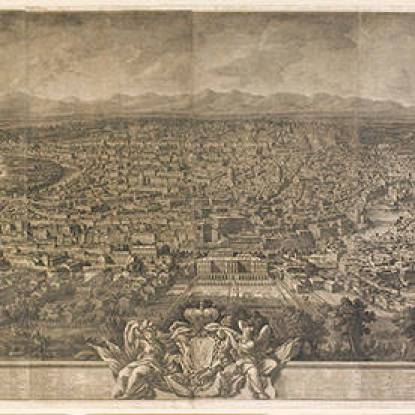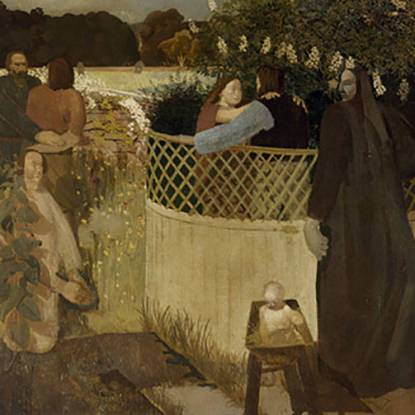A Brahmin and a Mohammedan in Earnest Converse for their Country’s Good. Monument to Major-General Sir Barry Close, Bart, 1815
Location: Mounted in the bottom left-hand corner of the South-west wall of the Flaxman Gallery, UCL Main Library.
The marble monument to Major general Sir Barry Close made from this model is in Madras, demonstrating Flaxman's international fame.
This work references the career of Major General Sir Barry Close and the uniting of native Hindu and Muslim leaders under the British East India Company. He served in the East India Company who paid for this monument. The finished marble of this working model is located at St. Mary’s Church, Fort St. George, Madras.
Major General Sir Barry Close (1756 – 1813)
During Close’s career, India was in a state of flux and Indian rulers such as the Muslim Tipu Sultan and the Hindu Maratha Rajas were in constant conflict with each other and with the British officials and traders of the East India Company. Close was involved in two of the major events that led to a shift in power from the Indian rulers to the East India Company. By depicting a conversation between a Hindu and a Muslim, Flaxman refers to the perceived pacifying and unifying effect of British control.
Having started as an infantry cadet at Madras in 1771, Close was Deputy Adjutant-General with Lord Cornwallis’ Army in India. He was presented with a sword of honour for his role in the siege of Seringpatem in 1799 in which Tipu Sultan, the East India Company’s greatest adversary in Southern India was defeated and killed. He was appointed British Resident at Mysore (1799 – 1801) and at Poona (1801 – 11) where he played an important role in negotiating the treaty of Bassein (1802) which led to the collapse in power of the Martha raja’s confederacy. On his return to Britain, the government conferred on him the non-hereditary tile of Baronet of Mysore. His legacy includes the Mysore town of Closepet, which was named after him.
Visit the Sir Barry Close Wikipedia page.
Tipu Sultan (1750 –1799)
While his treatment of the people he conquered and his non-Muslim subjects
is a topic of controversy, Tipu Sultan is widely heralded as a strong and beneficent ruler who did much to support the infrastructure and culture of Mysore.
Popularly known as ‘The Tiger of Mysore’, (his famous mechanical tiger is one of the highlights of the Victoria & Albert museum collection) Tipu Sultan, like his father is also viewed as one of the outstanding heroes of Indian opposition to British rule. The Muslim ruler of the predominantly Hindu province of Mysore, Tipu’s vehement opposition of East India Company made him a decisive leader in 3 of the 4 Anglo-Mysore Wars. The final of these ended with his death at the siege of his capital at Seringpatem in 1799.
Visit the Tipu Sultan Wikipedia page.
 Close
Close




